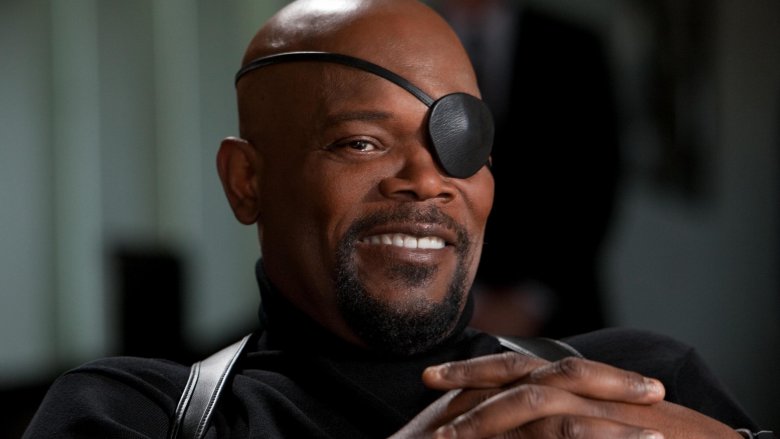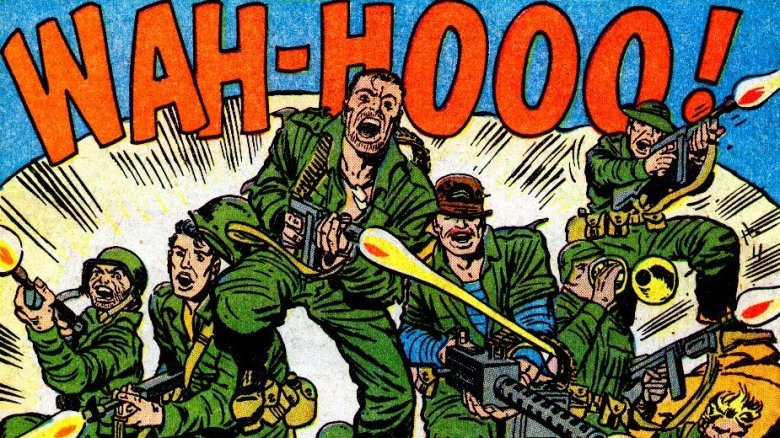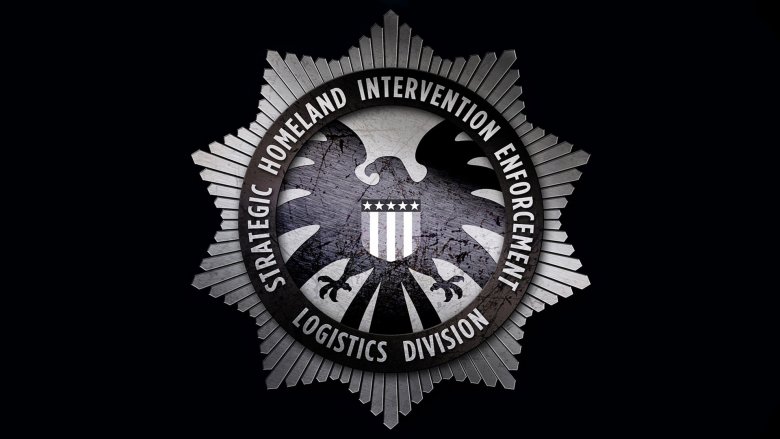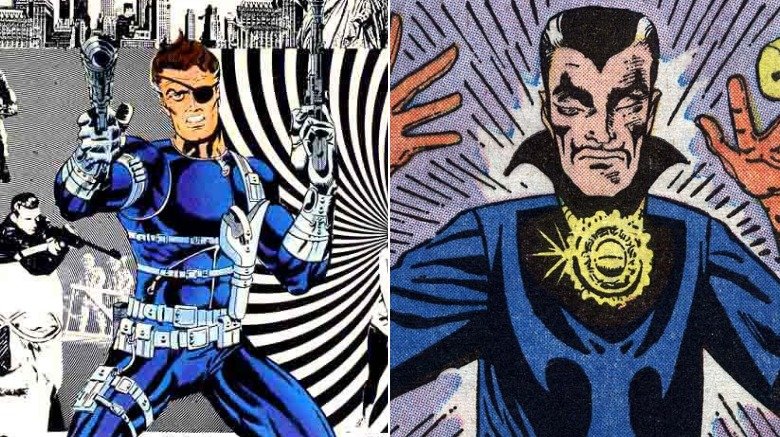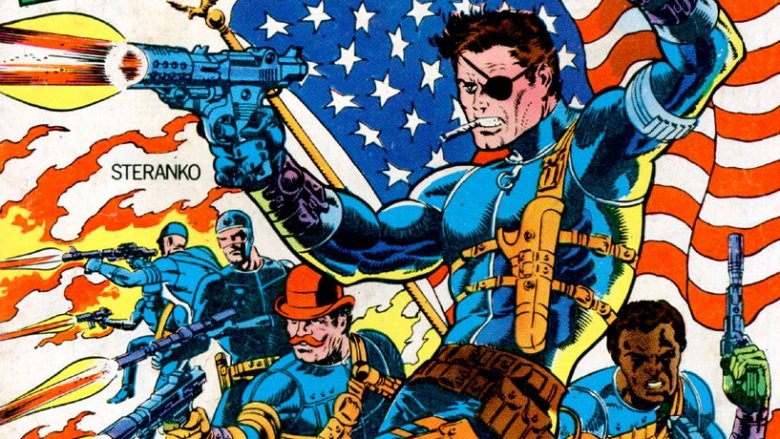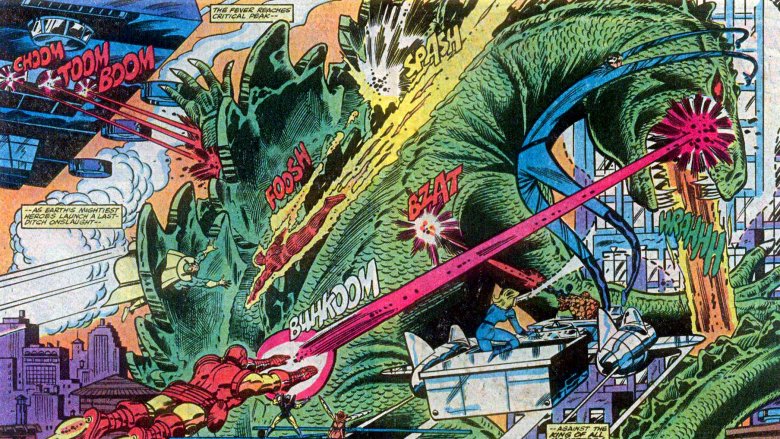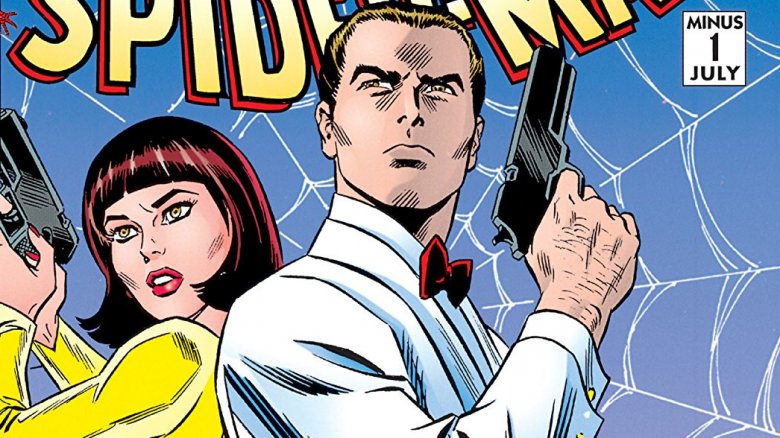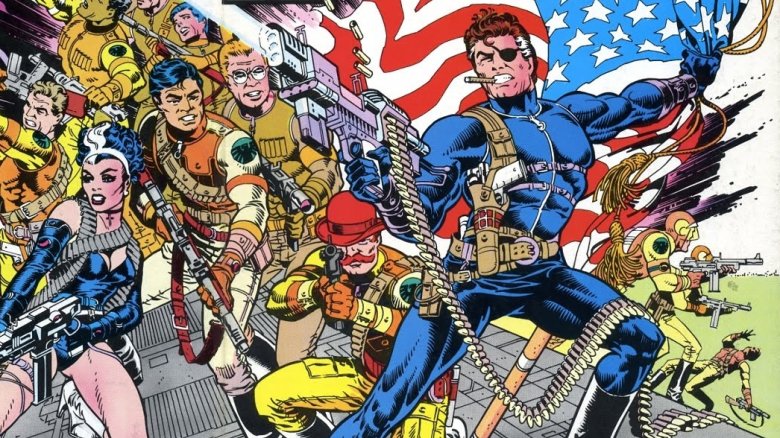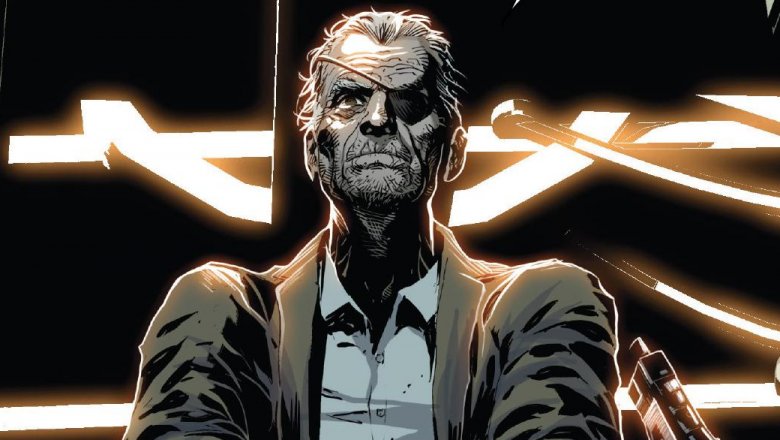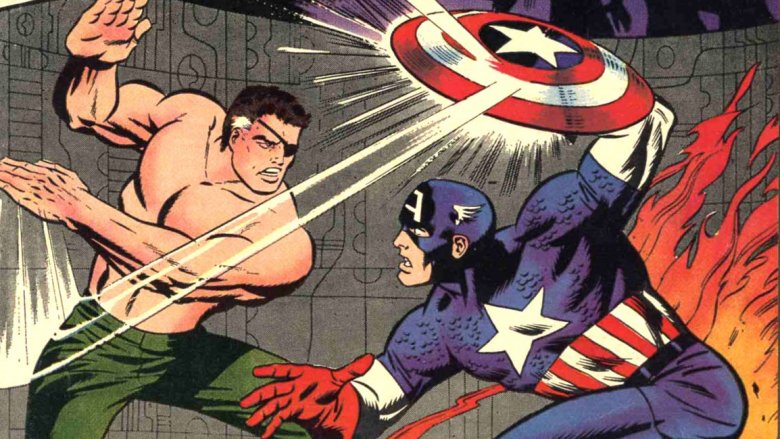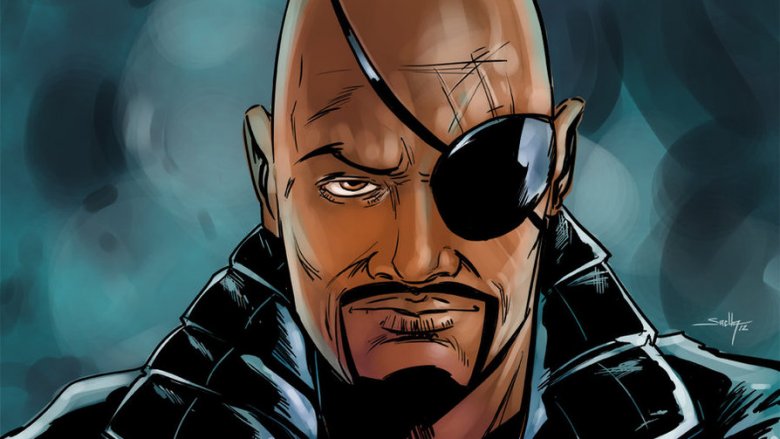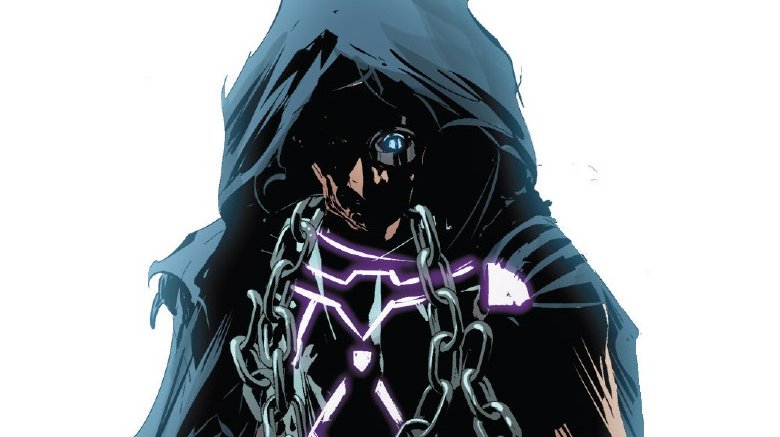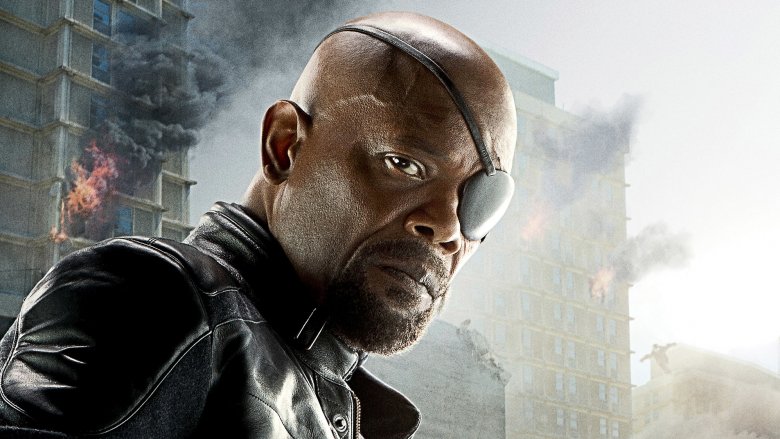The Untold Truth Of Nick Fury
He may be the glue that holds together the Marvel Cinematic Universe, but Nick Fury — and his organization, the Strategic Homeland Intervention, Enforcement, and Logisitics Division (call them S.H.I.E.L.D.) — have filled a similar function in the pages of Marvel comics for decades. Fury and his story have undergone quite an evolution in that time. Casual fans may only know him as the enigmatic superspy portrayed by Samuel L. Jackson in the MCU, but his comics incarnation rose through the ranks like all good soldiers on his way to becoming the globe-trotting badass prone to crossing paths with everyone from the Master of the Mystic Arts to a certain fire-breathing lizard of some note.
An unscripted cameo in a post-credits sequence at the conclusion of a mad gamble of a movie made him an instant worldwide icon, but the character's journey to that point and beyond was a long and twisting one. Let's take a closer look at the lesser-known history of the man of a million secrets, the consummate secret agent; the untold truth of Nicholas J. Fury.
Sgt. Fury and his Howling Commandos
Fury's colorful career began as a humble sergeant in the U.S. Army, a ranger recruited by Captain "Happy" Sam Sawyer to lead the First Attack Squad. The unit was based in the U.K. and tasked with carrying out specialized and highly dangerous missions during World War II. Their first success — the recovery of a British rocket scientist from a Nazi base in Norway — led to their incorporation into the British Army, where they were given the title that graced the cover of their first appearance in May of 1963: Sgt. Fury and His Howling Commandos.
The later years of the war would see the squad crossing paths with the super-soldier Captain America, as well as his nemeses Baron Zemo and the Red Skull. They would reunite for future conflicts, including the Korean War (which saw Fury promoted to lieutenant) and the Vietnam conflict. The multi-cultural squad (which gave Marvel writers a chance to address bigotry and institutional racism during the real-world struggle for civil rights in the '60s) featured standout characters such as Dum Dum Dugan, Gabe Jones, and Jim Morita, many of whom would later be recruited by Fury into the shadowy organization formed primarily to counter the threat of Hydra, the nefarious, centuries-old organization that had insinuated itself into the Nazi party during the war.
The genesis of S.H.I.E.L.D.
During the war, Fury sustained the grenade injury that left him nearly blind in his left eye, but this did little to slow down his career. His exploits had garnered the attention of the OSS, which recruited him for espionage purposes after the conflict ended, and Fury stayed with the organization during its transition to the CIA. It was actually Fury's idea, for which he drew up detailed plans, to incorporate a branch of the U.S. government to deal with Hydra and other non-traditional threats to world security. Believing that the government would shoot down his proposal, he abandoned it — but his plans were mysteriously obtained by a U.N.-based group which gained approval from the feds, and without Fury's knowledge, S.H.I.E.L.D. was born.
Although the organization was run by a mysterious Executive Board, it was determined that it needed a public face, and Fury was deemed to be the man for the job. In a situation which would see a curious reversal in the characters' film incarnations, Fury was offered directorship of S.H.I.E.L.D. by none other than Tony Stark, who was almost certainly — although this was never confirmed — a member of the Executive Board. This event, however, would be retconned in later years.
Beginning in 1965, Fury's adventures with S.H.I.E.L.D. were chronicled in a book previously reserved for tales of monsters, ghosts, and sorcerers — and one sorcerer in particular, who had featured prominently in the title for two years prior.
He shared a book with Doctor Strange
Strange Tales had run for over a decade as an anthology horror book, beginning in the early '60s to feature the Thing and the Human Torch as protagonists of its otherworldly stories. In 1963, a new character took center stage in the title: Doctor Strange, Master of the Mystic Arts. Extradimensional villains such the the dread Dormammu were introduced in its pages, but starting with issue #135 — as a result of the popularity of James Bond and the TV series The Man From U.N.C.L.E. — Strange was given split billing with Nick Fury, Agent of S.H.I.E.L.D.
Fury was even given his own "Bond girl" in sidekick Countess Valeria, as well as his own "Q" in Gaffer, the head of S.H.I.E.L.D.'s gadget division. In the pages of Strange Tales, Fury — with help from the likes of the Fantastic Four and Captain America — would face off against foes such as Baron Strucker, Yellow Claw, and Dr. Doom, while the Doctor Strange segments saw the sorcerer tangling with nemeses like Baron Mordo and the Living Tribunal. Beginning in 1968, Nick Fury, Agent of S.H.I.E.L.D. was split into its own title, while Strange Tales was renamed after the good Doctor. Both books would go on to produce some of the most influential art in comics history, with Nick Fury spearheaded by one of Marvel's most talented up-and-coming artists.
Pushing the boundaries
Comics legend Jim Steranko began his career at Marvel with Strange Tales #151, and almost immediately, he set about the task of revamping Fury — who at that point was still a rather nondescript character — in his own unique image. In a recent Collider interview, Steranko spoke about his early years with the House of Ideas. "When I broke into comics I was an art director and design was part of my nature," he said. "In addition to that, I was reasonably cognizant of Op Art, Pop Art, surrealism and expressionism. I knew comics were a very forgiving form... They could accept trends other media couldn't reproduce quickly, so I thought it was a natural thing to import artistic movements like surreal art. It was always a mystery to me that it had never been done before."
In addition to incorporating such elements, Steranko made Fury over to look a bit like himself ("And if you don't like me, then what are you going to do about that?" he said) and outfitted him with what would become his signature look. "[I] thought I'd give him a tough visual persona by putting him into a skin-tight leather catsuit. In addition, I stylized that suit with belts, buckles, zippers and turned him into a sort of high-tech warrior. If he couldn't battle in the superpowers area at least he could on visual terms."
He led a fight against Godzilla
Owing to his directorship of S.H.I.E.L.D., Fury has had occasion to pop up in a wide variety of titles over the decades, but in the late '70s he found himself and his organization in the middle of a situation that was weird even for the Marvel Universe. In August of 1977, Godzilla, King of the Monsters began its 24-issue run, transplanting the iconic kaiju and several of his frenemies to Earth-616 to engage in some seriously bizarre storylines. Although Fury made the occasional appearance, his point man on the Godzilla situation was Dum Dum Dugan, who was tasked with taking down the monster with the help of (and sometimes, in opposition to) a young, sympathetic boy named Rob who happened to have a special bond with a gigantic mecha called Red Ronin.
The series saw Godzilla facing off with Devil Dinosaur (whose title briefly ran concurrently), taking on the Fantastic Four while temporarily shrunken down to human size, and — in the final issue — doing battle with pretty much all of the superheroes as he attempts to topple the Empire State Building. Although the combined efforts of the Avengers, Spider-Man, and others couldn't keep the titanic beast from reaching his target, he was single-handedly thwarted in his attempt to push it over by Thor, applying equal force from the other side of the skyscraper. Godzilla was a deeply weird and wildly entertaining book, chronicling the biggest (ahem) threat Fury and S.H.I.E.L.D. had ever faced.
He recruited Spider-Man's parents
Fury's past and history with S.H.I.E.L.D. have been subtly and not-so-subtly retconned several times, perhaps most notably in regards to his involvement with Richard and Mary Parker, the mysterious parents of the amazing Spider-Man. In a 1968 Spidey story arc, it was revealed that the Parkers had been a secret agent duo, although it was not disclosed which agency they were employed by; that, however, would change in 1997. As part of a "flashback month" event, Marvel published Untold Tales of Spider-Man number -1, in which it was explained that Richard had in fact been recruited by Fury during his time in the CIA. There, he met Mary, who had followed in her late father's footsteps in joining the Agency.
The couple embarked on a Canadian adventure in which they came to the rescue of Wolverine, shortly after which Mary became pregnant with Peter. According to the issue's cover (it's never made explicit in its story) the couple transitioned to bonafide agents of S.H.I.E.L.D., and after Peter's birth they returned to the field. They would eventually die in the line of duty, leaving their infant to be raised by his kindly aunt and uncle and setting him on a path which would see him become a friendly neighborhood wall-crawler — which never would have happened if not for Fury.
One of a kind
We all know that Fury holds a lot things close to the vest, but you may not know just how many things, and just how close. He's a man whose secrets have secrets, owing to his status as the highest-level S.H.I.E.L.D. operative to ever exist. He's the only agent to ever achieve the mysterious "33rd degree" ranking within the organization, which means that he's privy to information that literally nobody else on Earth has access to.
Among this uber-classified info: the location of all 28 secret S.H.I.E.L.D. bases scattered around the globe, which have come in handy for Fury and others in times of serious peril. He employed them for his personal use when he was forced into hiding after the events of the 2004 Secret War storyline, and also to house various anti-registration heroes during Civil War. While the "33rd degree" ranking is never mentioned, Fury's extreme level of classified knowledge was also ported over to the character's depiction in the Marvel Cinematic Universe; the intrepid Agents of S.H.I.E.L.D. have had occasion to make use of his secret bases more than once, although they were lucky not to be turned away for not having lanyards.
The Infinity Formula
More than a few comics characters have seen little change to their appearance over years or even decades, but in Fury's case, there's actually a canonical explanation for this. In Marvel Spotlight #31 from 1976, it was revealed that the injury Fury sustained during World War II which cost him the use of his eye very nearly cost him his life. He was saved by an inoculation of the Infinity Formula — a diluted version of a substance known as the Elixir of Immortality, created by Sir Isaac Newton in the 1600s.
This so-called "Infinity Formula" had the effect not only of saving Fury's life, but also of effectively keeping him from aging. The formula was administered by its creator, Professor Berthold Sternberg, but his assistance came with a price. Sternberg blackmailed Fury for years in exchange for the yearly inoculations which would basically keep him forever young; without them, Fury would begin to age rapidly. The formula was later acquired by career criminal Steel Harris, whose attempt to continue the blackmailing of Fury ended with his death at the hands of the S.H.I.E.L.D. director. Fury, having already begun to age, was saved once again when the Infinity Formula was recovered by his on-again-off-again lover Contessa Valentina Allegra De Fontaine, who delivered his inoculation with virtually no time to spare.
Man of many talents
One would expect the Marvel Universe's foremost superspy to possess an extensive set of combat and espionage skills, but in fact, "extensive" doesn't even begin to cover it. Fury is the ultimate S.H.I.E.L.D. agent, possessed of enough hardcore skills to practically qualify him as a superhero. For starters, his expertise in hand-to-hand combat is nearly unmatched; he was a heavyweight boxer during his time in the military, possesses belts in multiple martial arts disciplines, and has honed his fighting skills to the degree that he's able to hold his own against the likes of Captain America, one of Marvel's greatest unarmed combatants.
This is only the tip of the iceberg. During his decades in the military, the CIA, and S.H.I.E.L.D., he has acquired skills including (but not limited to) master-level tactical, strategic, and espionage abilities; advanced expertise in nearly every military skill set, such as demolitions, special forces, and paratrooper operations; ambidextrous sharpshoooter and marksman skills (despite being 95% blind in his left eye); fluency in at least four languages, including English, German, Japanese, and Russian; and the ability to drive, pilot, or otherwise operate virtually any vehicle. It would take an entire phalanx of standard-issue secret agents just to match Fury's skillset. It almost makes his bulletproof, fire-resistant bodysuit seem a bit unnecessary.
The Ultimate makeover
When Marvel's Ultimate line — featuring new interpretations of classic characters in an alternate universe — was launched in 2000, it didn't take more than a glance for fans to notice that Fury had undergone a bit of an aesthetic makeover. The Ultimate version of the character was no grizzled, cigar-chomping white man; instead, he looked a heck of a lot like beloved actor Samuel L. Jackson, and there's a reason for this. Famed comics scribe Mark Millar was responsible for the character's overhaul, and his thought process was simple: "Sam is famously the coolest man alive, and both myself and artist Bryan Hitch just liberally used him without asking any kind of permission," he told Business Insider. "You have to remember, this was 2001 when we were putting this together. The idea that this might become a movie seemed preposterous, as Marvel was just climbing out of bankruptcy at the time."
Unbeknownst to Millar, Jackson himself was a huge comic fan, and had noticed the "homage." Of course, the Ultimate depiction of Fury led directly to Jackson's casting in the role in the Marvel Cinematic Universe, so it's safe to say the actor wasn't exactly miffed. When the two met over a decade later on the set of Kingsman: The Golden Circle (based on a Millar comic), the writer asked Jackson if he was upset about his look being swiped. The actor's succinct response: "F*** no, man. Thanks for the nine picture deal."
Fury of two worlds
Aside from being black while his Earth-616 counterpart is white, Ultimate Fury had a few discrepancies in his biography. Rather than sustaining an injury on the frontlines of World War II, he damaged the eye during a skirmish between S.H.I.E.L.D. agents and Wolverine during the Gulf War. His natural abilities were augmented by the Super Soldier Serum, and he was known to actively lead the Ultimates (that universe's version of the Avengers) into battle. He also personally identified and kept tabs on Spider-Man, eventually recruiting him into S.H.I.E.L.D.
Meanwhile, in a strange instance of synchronicity between universes, Earth-616 Fury fathered a son, Nick Fury Jr., with CIA agent and former flame Nia Jones, who was black. As an adult, Fury Jr. came to look quite a bit like his father's Ultimate universe counterpart, who met his end when the Ultimate universe experienced an incursion into Earth-616, temporarily destroying both universes (although they were later recreated by an omnipotent Mister Fantastic). His fate, however, was nothing compared to that of Earth-616 fury, who was seemingly killed after a bizarre series of events led him to murder Uatu the Watcher in an attempt to access the otherworldly being's memories. For that transgression, the remaining Watchers transformed Fury into the Unseen, a wraith-like entity doomed to silently observe the Earth as Uatu had once done.
One bad mother
That nine picture deal Jackson was referring to will finally be fulfilled with his appearance in Captain Marvel, which (being set in the '90s) features a digitally de-aged Fury who still has the use of both his eyes. This, along with the fact that the superspy was seen crumbling to dust in an Avengers: Infinity War post-credits sequence, might lead some to believe that Fury's time in the MCU is up. This, however, is definitively not the case.
By virtue of sequels which have already been announced, we know that many of the heroes dusted during the events of Infinity War — Spider-Man, Back Panther, and Doctor Strange, at the very least — will somehow be making a return. This also goes for Fury, who will be featured in a prominent role in Spider-Man: Far From Home, taking over the mentor role for young Peter Parker in much the same fashion that his Ultimate comics inspiration did.
As for just how much Fury the 70-year-old Jackson has left in him, the baddest mother on the planet has an idea. Speaking with The Hollywood Reporter, he volunteered that he would happily play the role into his 80s, suggesting that he could be "the Alec Guinness of Marvel movies." Sure, he'd command a hefty salary, but we submit that no matter how much cash it takes to keep Nick Fury playing for your team, it'd be wise to pony it up.
